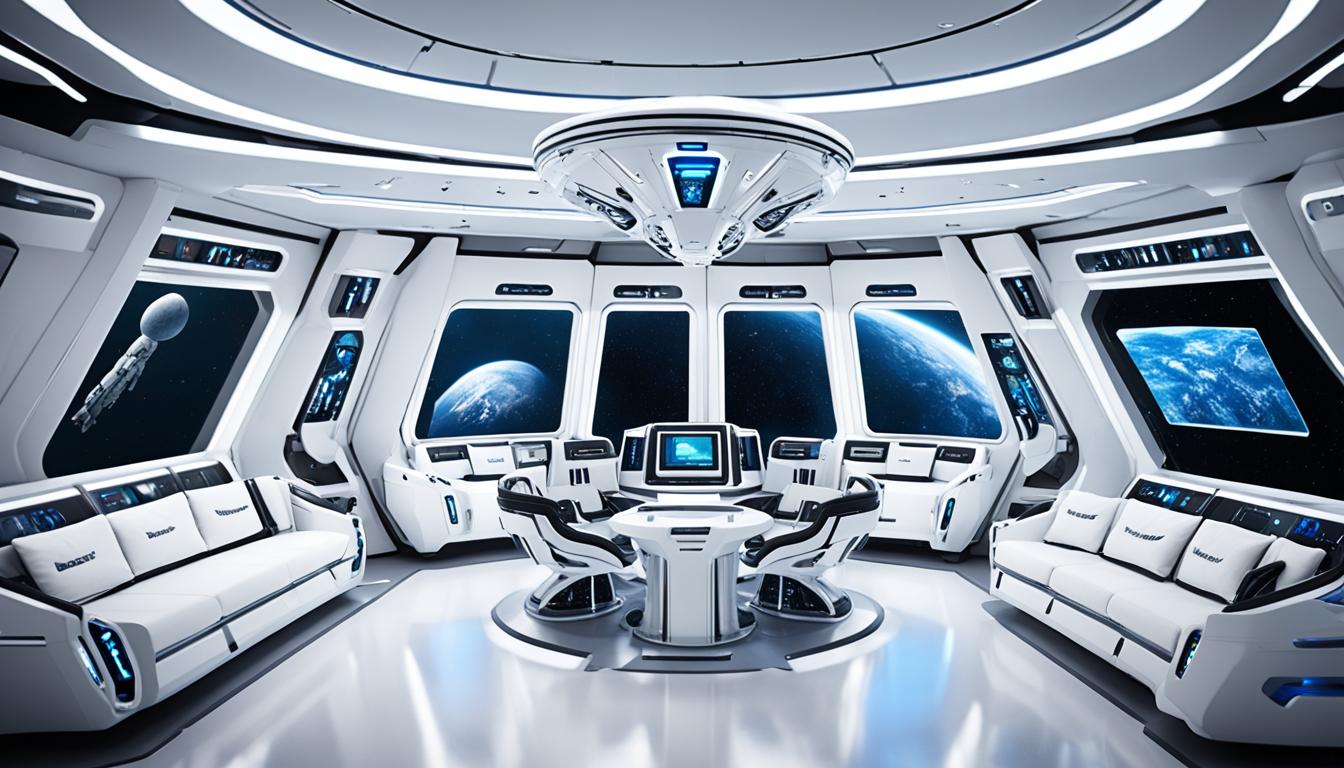Imagine a future where luxurious cosmic journeys are no longer the stuff of science fiction but a reality. Thanks to groundbreaking advancements in robotics and automation systems, space travel is undergoing a metamorphosis like never before. The robotics industry is experiencing exponential growth, with industrial robotics, automation software, and autonomous robots paving the way for a new era of cosmic exploration.
In this article, we will delve into the role of robotics in crafting extravagant space experiences. From the growing importance of robotics in space exploration to the advantages of automation in space travel, we will explore how robotics is revolutionizing the way we navigate the cosmos. We will also discuss the role of robots in space tourism, space mining and resource exploration, space manufacturing and construction, and the integration of robotics with human collaboration in space missions.
Furthermore, we will examine the impact of robotics and automation on the space industry and economy, as well as the ethical considerations surrounding their implementation. As we conclude, we will look to the future and envision the incredible possibilities that lie ahead as robotics and automation continue to shape the course of space exploration.
Key Takeaways:
- Robotics and automation are revolutionizing space travel, opening up extravagant cosmic experiences.
- Advancements in robotic technology and automation systems are driving the exponential growth of the robotics industry.
- Robots play a crucial role in space exploration, performing tasks such as satellite repair, space station maintenance, and planetary exploration.
- Automation in space travel brings increased efficiency, productivity, and reduced human error.
- Robotic automation technologies are transforming space tourism, mining, manufacturing, and construction.
The Growing Importance of Robotics in Space Exploration
Space exploration has always been an exciting endeavor, pushing the boundaries of human knowledge and discovery. In recent years, the growing importance of robotics in space exploration has revolutionized our approach to cosmic journeys. Robots, with their advanced capabilities and versatility, have become invaluable assets in various space missions, from repairing satellites to maintaining space stations and exploring distant planets.
One of the key advantages of robotics in space exploration is their ability to operate in harsh and inhospitable environments that would be challenging, if not impossible, for humans. These robotic systems are designed to withstand extreme temperatures, radiation, and vacuum conditions without compromising their functionality. They can perform intricate tasks with precision and accuracy, gathering data and conducting experiments that are vital for expanding our understanding of the cosmos.
Robotics in space exploration encompasses a wide range of applications. Some robots are remotely controlled by humans on Earth, allowing us to navigate and manipulate them with utmost control. This form of robot programming enables intricate maneuvers and delicate operations, ensuring successful mission outcomes. On the other hand, autonomous robots are also deployed in space, capable of operating independently and making decisions based on pre-programmed instructions or adaptive algorithms.
The use of robotic systems in space exploration has significantly accelerated our progress in unraveling the mysteries of the universe. From the exploration of other planets to the search for signs of life beyond Earth’s boundaries, robots have played a pivotal role in collecting data, analyzing samples, and transmitting valuable information back to Earth.
Robots act as our eyes and hands in the vastness of space, extending our reach and capabilities as we explore realms beyond our home planet.
The role of industrial automation in space exploration cannot be understated either. Automated systems streamline operations, optimize resource utilization, and ensure the smooth functioning of space missions. In addition to their physical capabilities, robotics also integrate artificial intelligence, making them capable of learning and adapting to changing conditions in space. This combination of robotics and automation has the potential to revolutionize the future of space exploration.
The Future of Robotics in Space Exploration
As we look to the future, the importance of robotics in space exploration will only continue to grow. Advancements in robotics engineering and technology will lead to the development of more advanced and capable robots, capable of tackling even more complex tasks and venturing into unexplored territories. With each new mission, our knowledge of the universe expands, fueling our aspirations for cosmic exploration.
Robotics and automation have already paved the way for space tourism, enabling individuals to experience the wonders of space firsthand. Autonomous robots serve as guides and assistants, enhancing the comfort and safety of space tourists, while also providing interactive and personalized experiences.
Furthermore, robotics in space exploration is crucial for resource mining and utilization. As our reliance on extraterrestrial resources increases, robots will play a vital role in extracting and processing raw materials on celestial bodies, ensuring the sustainability and feasibility of future space missions.
| Application | Key Benefits |
|---|---|
| Satellite Repair | Extend the lifespan of orbiting satellites, reducing costs and minimizing space debris. |
| Space Station Maintenance | Perform complex repairs and routine maintenance tasks, freeing up human crew members for critical scientific experiments. |
| Planetary Exploration | Gather valuable data and samples from other planets, providing insights into their composition and potential habitability. |
https://www.youtube.com/watch?v=uYapD7UzyxE
In conclusion, the growing importance of robotics in space exploration opens up new horizons for human knowledge and discovery. With their ability to withstand harsh conditions, perform intricate tasks, and expand our reach in the cosmos, robots have become indispensable assets in our cosmic journeys. As robotics engineering and technology continue to advance, we can expect even more remarkable achievements in space exploration, making the dream of exploring the unknown a reality.
The Advantages of Automation in Space Travel
Automation plays a pivotal role in space travel, offering a multitude of advantages that enhance efficiency, productivity, and safety. By harnessing advanced automation systems, space missions can optimize performance and achieve greater levels of success. Let’s explore the key advantages that automation brings to the cosmos.
Increased Efficiency
Automation systems streamline space operations by taking over repetitive and time-consuming tasks. Robots equipped with automation technology can carry out these tasks with unmatched precision and speed, ensuring optimum efficiency throughout the mission. For example, robotic automation solutions can handle tasks such as equipment maintenance, data collection, and payload deployment seamlessly, allowing astronauts to focus on more complex and critical activities.
Higher Productivity
Automated processes eliminate delays and bottlenecks, significantly improving productivity in space travel. By automating routine tasks, astronaut teams can accomplish more in less time, maximizing the utilization of resources and achieving mission objectives with greater efficiency. This increased productivity enables space agencies and private companies to conduct more missions and accelerate the pace of scientific research and exploration.
Reduced Human Error
Automation technology minimizes the risk of human error in space travel. Complex tasks that demand precision and accuracy can be susceptible to mistakes when performed manually. By leveraging robotics and automation systems, the potential for errors can be greatly reduced. Advanced algorithms and artificial intelligence integrated into robotic systems enable machines to learn and adapt to the challenging conditions of space, further minimizing the margin for error.
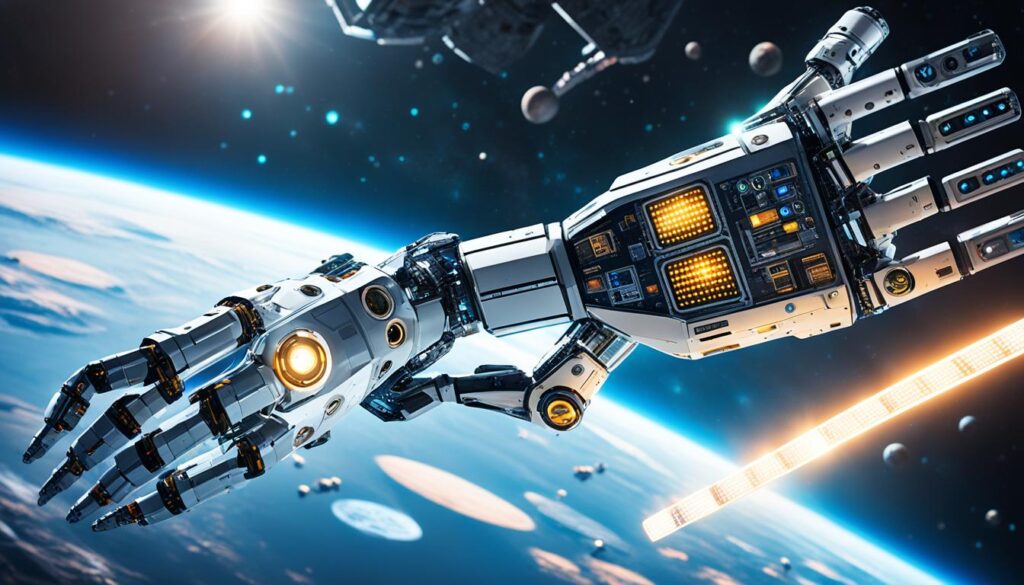
Artificial Intelligence in Robotics has revolutionized automation in space travel, allowing robots to make intelligent decisions based on real-time data and adapt to changing circumstances. This integration of AI enhances the capabilities of robotic systems and enables them to navigate complex environments, interact with objects, and perform tasks autonomously.
In Summary
Automation is a game-changer in space travel, offering increased efficiency, higher productivity, and reduced human error. By incorporating automation systems and artificial intelligence into robotic technologies, space missions can achieve new levels of precision, safety, and success. As we continue to explore the cosmos, the advantages of automation will play an increasingly vital role in shaping the future of space travel and exploration.
The Role of Robotics in Space Tourism
As space tourism becomes a reality, robotics and automation are playing a crucial role in enhancing the experience for travelers. The applications of robotics and automation in the space tourism industry are diverse, ranging from robotic guides and concierge services to automated systems for entertainment and comfort. These advancements in robotic technology are transforming the way we interact with space environments, making cosmic journeys more luxurious and personalized.
Robotic automation companies have been at the forefront of creating innovative solutions to cater to the needs of space tourists. These companies develop autonomous robots and provide robotic automation solutions that ensure a seamless and unforgettable experience. From providing assistance during spacewalks to managing spacecraft amenities, robots are becoming indispensable in the space tourism sector.
“Space tourism is no longer limited to sightseeing. The integration of robotics and automation has opened up new possibilities in creating immersive and extraordinary experiences for space travelers. Robots are not just companions, but they serve as efficient and reliable assistants, making space tourism safer, more enjoyable, and truly out of this world.”
– Dr. Jane Anderson, Robotics Expert
One of the key advantages of using robots in space tourism is their ability to navigate and perform tasks in microgravity environments, where human capabilities may be limited. Robotic technologies, such as autonomous navigation systems and sensory perception, enable robots to adapt to the challenges of space travel and provide valuable support to astronauts and tourists alike.
Moreover, robots are designed to handle the harsh conditions of space, including extreme temperatures, radiation, and vacuum. This ensures the safety and well-being of space tourists, as robots can perform high-risk activities while minimizing the risks associated with human presence.
| Benefits of Robotics in Space Tourism | Examples |
|---|---|
| Enhanced Safety | Robots equipped with sensors can detect potential hazards and mitigate risks, ensuring the safety of space tourists. |
| Premium Services | Robotic concierge services provide personalized assistance, from arranging meals to entertainment options, making the journey more enjoyable. |
| Efficient Operations | Robots can streamline operations, from managing waste disposal to maintaining spacecraft facilities, optimizing resources and reducing manual efforts. |
| Unique Experiences | Robotic guides offer interactive tours and educational experiences, providing tourists with a deeper understanding of the cosmos. |
As space tourism continues to evolve, the role of robotics and automation will become increasingly significant. Innovations in robotic technology and automation solutions will shape the future of space tourism, offering unparalleled cosmic adventures to those who dare to explore beyond Earth.
Robotics in Space Mining and Resource Exploration
The exploration and mining of extraterrestrial resources are essential for future space missions and colonization. Robotics plays a crucial role in this endeavor, as robotic systems can be sent to remote celestial bodies to gather data, extract resources, and conduct experiments. With advancements in automation technology, robotic mining and resource exploration in space are becoming more efficient and cost-effective.
The Benefits of Robotics in Space Mining
Robotic systems offer numerous advantages in space mining and resource exploration. Their capabilities enable them to overcome the challenges posed by the extraterrestrial environment. Here are some key benefits:
- Efficiency: Robots can conduct repetitive tasks with precision, improving overall efficiency in resource extraction and data collection.
- Safety: Robotic systems can withstand hazardous conditions and radiation, reducing the risks to human miners or astronauts.
- Exploration: Robots can venture into inaccessible areas of celestial bodies, providing valuable data and insights for future missions.
- Cost-Effectiveness: Robotic mining eliminates the need for extensive life support systems, reducing the cost of human presence in space.
By utilizing robotics in space mining and resource exploration, we can unlock the potential of extraterrestrial resources, paving the way for sustainable space colonization and scientific discoveries.
“Robotic mining and resource exploration offer immense opportunities for unlocking the potential of space resources and expanding our understanding of the cosmos.” – Dr. Lisa Reynolds, Robotics Engineer
Rover Exploration and In-Situ Resource Utilization (ISRU)
Rovers are an essential tool in space mining and resource exploration. These robust robotic vehicles are designed to navigate and explore the surface of celestial bodies, collecting samples and analyzing the composition of minerals and resources.
Through the process of In-Situ Resource Utilization (ISRU), robots can extract and process resources found on celestial bodies, such as the Moon or Mars, to create essential materials needed for sustained human presence in space. This includes extracting water ice for drinking water, oxygen production, and fuel manufacturing.
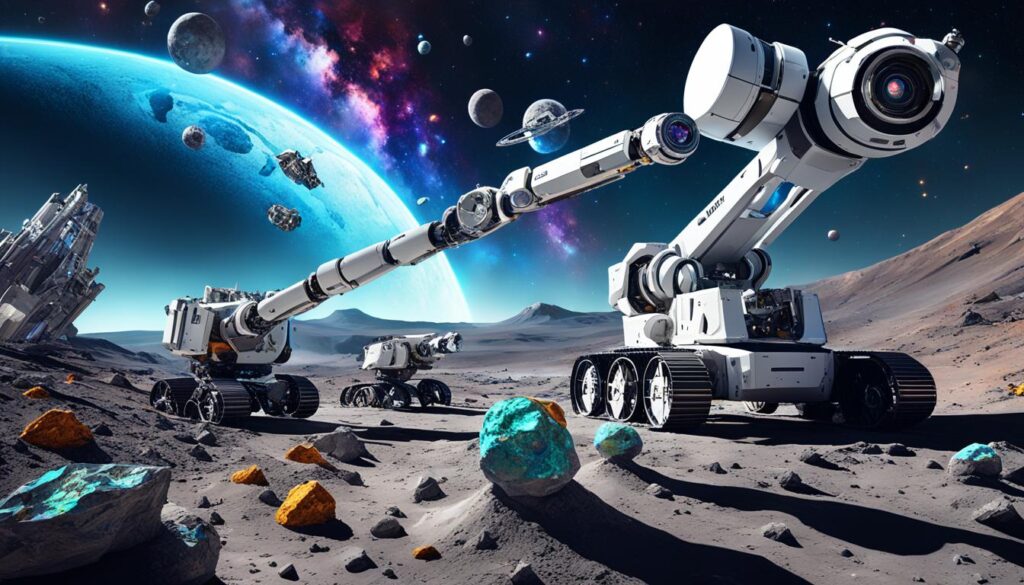
| Robotic Systems in Space Mining | Description |
|---|---|
| Lunar Rovers | Autonomous robotic vehicles that explore the lunar surface, mapping resources and conducting scientific experiments. |
| Mining Robots | Specialized robots equipped with drilling and excavation capabilities for extracting resources from asteroids or planetary surfaces. |
| Regolith Harvesters | Robotic systems designed to collect and process regolith (loose surface material) for resource extraction. |
These robotic systems, combined with advanced automation technology, enable efficient resource extraction in space, contributing to the development of sustainable infrastructure and the establishment of long-term human presence beyond Earth.
By leveraging the power of robotics and automation, the future of space mining and resource exploration holds tremendous potential for scientific advancement, economic growth, and ensuring the sustainability of future space missions.
Robotics in Space Manufacturing and Construction
Space manufacturing and construction require the precision and efficiency of advanced robotic systems. These robots play a crucial role in assembling structures, repairing equipment, and manufacturing components in space. By utilizing robotics and automation, the need for human astronauts to perform these tasks is greatly reduced, allowing them to focus on other critical activities.
Industrial automation systems have a significant impact on streamlining space manufacturing processes, ensuring the quality and reliability of space infrastructure. These systems optimize production, enhance precision, and improve overall efficiency in the space manufacturing industry.
“The integration of robotics in space manufacturing and construction has revolutionized the way we build in the cosmos. Robots are capable of working in extreme conditions without the limitations of human astronauts, effectively accelerating space construction projects.”
The Benefits of Robotics in Space Manufacturing and Construction
Robotic technology brings several advantages to space manufacturing and construction, including:
- Enhanced Efficiency: Robots can perform tasks with speed, precision, and consistency, minimizing production time and improving overall efficiency.
- Reduced Risk: By replacing humans in hazardous construction environments, robots help mitigate risks and ensure astronaut safety.
- Increased Reliability: Robots eliminate human error, resulting in improved quality control and more reliable space infrastructure.
- Cost Savings: The use of robotics and automation reduces the expenses associated with human labor, making space manufacturing and construction more economically viable.
The Role of Automation Systems in Space Manufacturing
Automation systems play a vital role in space manufacturing, offering the following benefits:
- Process Optimization: Advanced automation systems optimize manufacturing workflows, ensuring seamless coordination between robots and minimizing downtime.
- Quality Assurance: Automation systems perform rigorous quality checks, guaranteeing the high standard of space structures and equipment.
- Remote Operation: Automation systems enable remote operation of robots, allowing tasks to be executed on distant celestial bodies without human presence.
- Data Analysis: Automation software provides real-time data analysis, empowering manufacturers to make informed decisions and optimize production processes.
By integrating robotics and automation systems in space manufacturing and construction, we can unlock the potential for rapid development and expansion of space infrastructure.
The Future of Robotics in Space Construction
As technologies continue to advance, the future of robotics in space construction looks promising. With ongoing research and development, we can expect to see:
- Innovations in Robotic Techniques: New robotic techniques and capabilities will enable the construction of larger and more complex structures in space.
- Collaborative Robotics: Robots and humans will work together in space construction projects, leveraging their respective strengths for optimal results.
- Nanorobotics: Advancements in nanorobotics will enable the manipulation and assembly of materials at the atomic and molecular levels, revolutionizing space construction processes.
The continued integration of robotics and automation in space manufacturing and construction will drive the expansion of space exploration and further our understanding of the universe.
The Future of Robotics and Automation in Space
The future of robotics and automation in space holds immense potential. As robotic technology and automation software continue to advance, the capabilities of robots in space are constantly improving. From increased autonomy and adaptability to advanced sensing and decision-making capabilities, robots will play a crucial role in future space exploration, making cosmic journeys safer, more efficient, and more luxurious.
“The possibilities for robotics and automation in space are endless. These technologies will revolutionize the way we explore and interact with the cosmos.”
With robotic process automation and automation software, space missions will become more streamlined and efficient. Robots will be able to execute complex tasks, allowing astronauts to focus on critical activities and scientific research. The integration of robotics and automation will enhance the productivity and success of future space missions.
Beyond the functionality of robots, advancements in robotic technology will also improve the safety and comfort of space travel. Robots equipped with sophisticated sensors and decision-making capabilities will be able to navigate hazardous environments with precision and provide necessary support for astronauts.
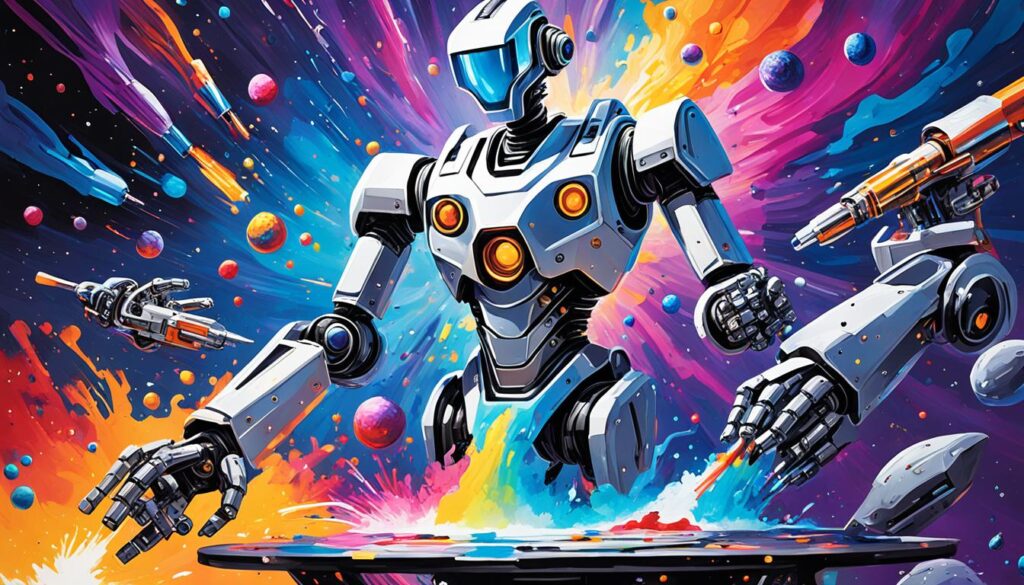
In addition, the use of robotics and automation will pave the way for innovative space exploration and colonization. Autonomous robots can be deployed to remote celestial bodies to gather data, extract resources, and conduct experiments. This will contribute to the development of sustainable space mining and resource exploration, enabling long-term space missions and future human settlements.
Key Innovations in Space Robotics:
- Enhanced autonomy and adaptability
- Advanced sensing and decision-making capabilities
- Streamlined mission operations through robotic process automation
- Improved safety and comfort for astronauts
- Efficient and cost-effective resource extraction through autonomous robots
The future of robotics and automation in space is promising, with the potential to revolutionize space exploration and open up new frontiers. As technology continues to advance, robots will become indispensable companions in our cosmic journeys, enabling us to unravel the mysteries of the universe.
Ethical Considerations in Space Robotics and Automation
As robotics and automation technology continues to advance, it becomes imperative to address the ethical considerations surrounding their use in space exploration. The integration of artificial intelligence in robotics and the rapid development of robotic technology raise important questions about the potential impact on human astronauts, decision-making processes, and the future workforce. Striking a balance between the benefits and risks associated with space robotics and automation is crucial to ensure responsible and ethical practices in our quest to explore the cosmos.
The Displacement of Human Astronauts
One key ethical consideration in space robotics and automation is the potential displacement of human astronauts. As robots become more capable and autonomous, there is a concern that they may replace human astronauts in certain tasks and missions. While robotics technology offers many advantages in terms of efficiency, safety, and precision, it is essential to carefully assess the role and involvement of human astronauts to maintain the value of human exploration and the unique qualities they bring to space missions.
The Role of Artificial Intelligence in Decision-Making
Artificial intelligence plays a significant role in enabling robots to make autonomous decisions in space. However, the ethical implications of relying on AI for critical decisions need to be thoroughly examined. Ensuring transparency, accountability, and the ability to override AI decisions when necessary are vital aspects of maintaining human control and responsibility in space exploration. Striking the right balance between AI-enabled decision-making and human oversight is crucial to uphold ethical standards in space robotics.
The Impact on the Future Workforce
The integration of robotics and automation in space has the potential to impact the future workforce in various ways. While robots can perform repetitive and physically demanding tasks more efficiently, this could result in a reduced need for human involvement in certain aspects of space exploration. It becomes crucial to consider the implications for job displacement and ensure that adequate measures are taken to safeguard the livelihoods and professional development of those affected. This involves retraining and providing opportunities for workers to transition into new roles aligned with the evolving requirements of space robotics and automation.
“Ethical considerations are essential to guide the responsible use of robotics and automation in space, ensuring that the benefits they offer are harnessed in a way that aligns with our values and respects the contribution of human astronauts.”
In conclusion, as robotics and automation play an increasingly significant role in space exploration, we must address the ethical considerations associated with their use. The potential displacement of human astronauts, the role of artificial intelligence in decision-making, and the impact on the future workforce are key areas that require careful examination. By embracing responsible practices and striking the right balance between human involvement and autonomous systems, we can ensure that space robotics and automation contribute to our understanding of the cosmos while upholding ethical standards.
The Integration of Robotics and Human Collaboration in Space
The exploration of space and the advancement of our cosmic knowledge is a collaborative effort between humans and robots. The integration of robotics and human collaboration plays a crucial role in enabling successful space missions and unlocking new frontiers in space exploration. Robots, equipped with autonomous capabilities, assist astronauts in performing tasks, providing critical support, and enhancing overall mission success.
Industrial robotics and robotic automation companies are at the forefront of developing advanced systems that facilitate seamless collaboration between humans and robots in space environments. These cutting-edge technologies combine the precision and efficiency of robotic systems with the decision-making abilities of human astronauts. By leveraging the expertise of both humans and robots, space agencies and exploration ventures can achieve greater success and uncover even more profound cosmic insights.
Benefits of Robotics and Human Collaboration in Space
“The integration of robotics and human collaboration in space brings numerous benefits to space exploration and cosmic research. Together, humans and robots harness their unique capabilities to overcome challenges and achieve breakthroughs beyond what either can accomplish alone.”
Here are some key advantages of integrating robotics and human collaboration in space:
- Efficiency: Robots can perform repetitive and physically demanding tasks, freeing up astronauts to focus on more complex and critical activities.
- Precision and Accuracy: Robotic systems are designed to perform tasks with exceptional precision, reducing the risk of human error and ensuring high-quality results.
- Remote Exploration: Robots equipped with advanced sensors and cameras can be deployed to explore remote or hazardous environments, gathering critical data and expanding our understanding of the cosmos.
- Dexterity and Adaptability: Robots can be engineered to adapt to various space environments, enabling them to undertake a wide range of tasks, from repairs and maintenance to scientific experiments.
- Safety: By leveraging robotics for tasks involving risk or exposure to harsh conditions, we can mitigate the potential dangers faced by human astronauts.
The integration of robotics and human collaboration in space creates synergistic capabilities, combining the strengths of both humans and robots to foster exploration, enhance scientific discovery, and ensure the success of future cosmic missions.
| Robotic Systems | Industrial Robotics | Robotics Engineering | Robotic Automation Companies |
|---|---|---|---|
| Robotic arms for precise manipulation | Robots designed for industrial applications | Development of advanced robotic technologies | Companies specializing in robotic automation solutions for space exploration |
| Autonomous rovers for extraterrestrial exploration | Automation of manufacturing processes in the space industry | Design and optimization of robotic systems for space missions | Leading providers of robotic systems for cosmic endeavors |
| Robotic companions for astronauts | Integration of robots in space manufacturing and construction | Expertise in developing robotic software and hardware | Innovators in the field of robotic automation for space exploration |
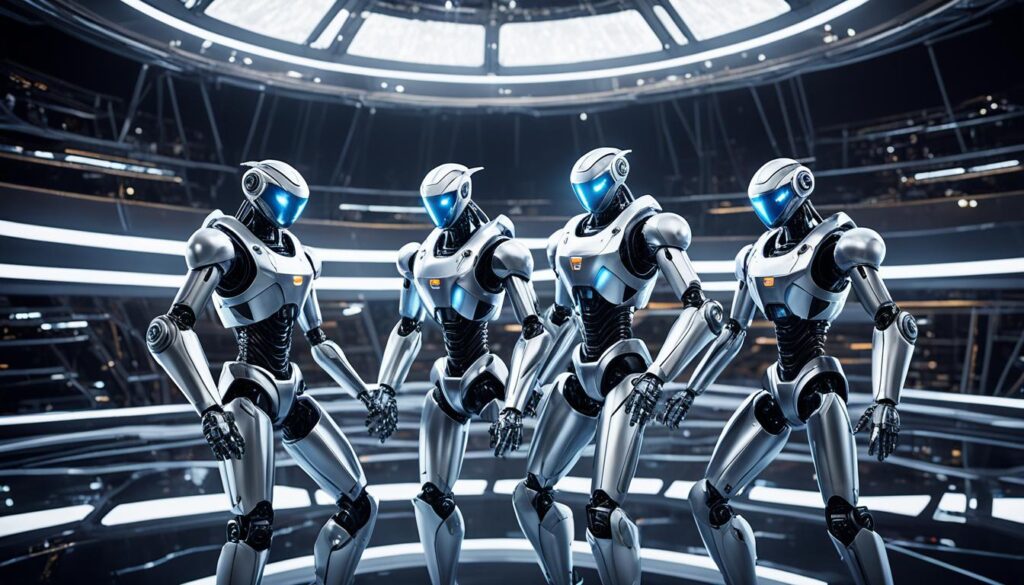
The Impact of Robotics and Automation on Space Industry and Economy
As the space industry continues to evolve, the integration of robotics and automation plays a pivotal role in driving growth and transforming the economy. Automation systems are revolutionizing the operational efficiency of space missions, leading to cost reductions and enabling the development of innovative products and services. Robotic process automation, in particular, streamlines workflows and enhances productivity, making a significant contribution to the economic expansion of the space sector.
By leveraging automation systems, the space industry can optimize processes, reduce human error, and achieve greater precision in various operations. Robotic automation solutions facilitate the seamless execution of complex tasks, enabling astronauts and engineers to focus on critical activities and scientific exploration. This enhanced efficiency not only accelerates space missions but also leads to advancements in technology and research, benefiting both the industry and the overall economy.
“The integration of robotics and automation enhances operational efficiency, reduces costs, and drives economic growth in the space sector.”
Moreover, the implementation of robotic technology and automation systems in space exploration enables the development of new products and services. From advanced propulsion systems to cutting-edge scientific instruments, the space industry continues to push boundaries with the help of robotics. Automation allows for the invention of novel technologies and methodologies, leading to breakthroughs in space research and exploration.
“Automation systems drive innovation and enable the development of groundbreaking technologies in the space industry.”
Looking ahead, the continued advancement of robotics and automation will shape the future of the space industry and contribute to its expansion. With ongoing research and development, robotics technology is becoming more sophisticated and adaptable, paving the way for more efficient and reliable space missions. The integration of automation systems will not only streamline existing processes but also unlock new possibilities and opportunities for cosmic exploration.
“The future of the space industry lies in the seamless integration of robotics and automation, propelling us toward new frontiers of exploration.”
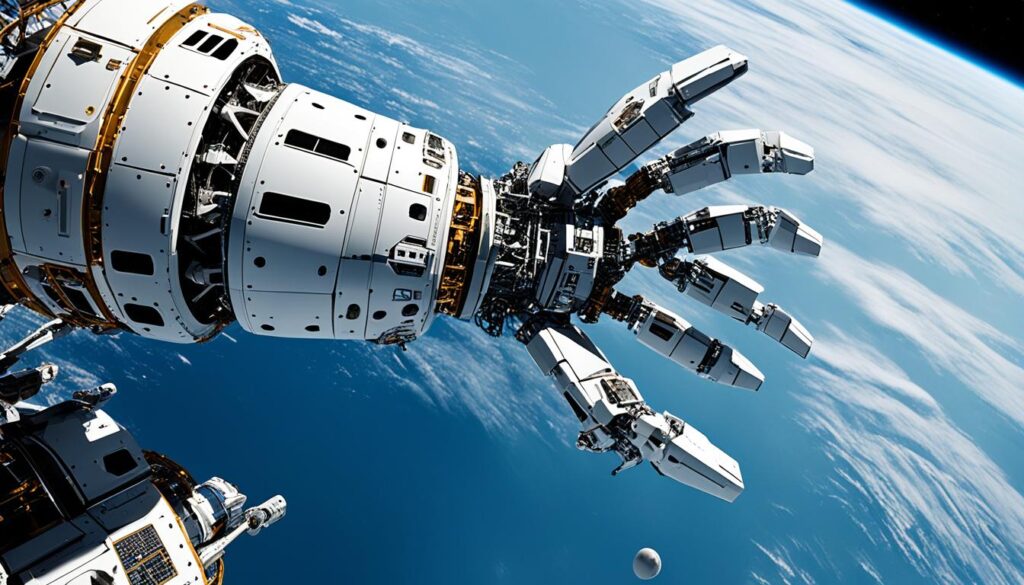
In conclusion, the impact of robotics and automation on the space industry and economy is undeniable. Automation systems improve operational efficiency, reduce costs, and enable the development of new products and services in space. The continued advancement of robotic technology and automation will shape the future of the space industry, expanding our cosmic horizons and driving economic growth.
Conclusion
Robotics and automation have revolutionized the space industry, offering remarkable opportunities for cosmic exploration. Through the integration of robotic technology and automation systems, we have witnessed advancements in space travel, bringing luxurious experiences and expanding our understanding of the universe. From the captivating exploration of distant celestial bodies to the exciting prospect of space tourism and resource extraction, robots are playing a crucial role in shaping the future of space exploration.
As technology continues to progress, the possibilities for robotics and automation in space are boundless. These innovative solutions enable us to navigate the cosmos with efficiency and precision, unlocking new frontiers and enhancing our cosmic adventures. By leveraging the expertise of robotics engineering and embracing automation technology, industrial automation has significantly impacted our ability to explore the unknown.
Looking ahead, we can anticipate a future where robotics and automation become even more deeply embedded in the fabric of space travel. The development of robotic automation solutions and the continuous advancement of robotics engineering will drive breakthroughs in industrial automation, paving the way for remarkable developments. With every stride made in robotics and automation, we inch closer to unlocking the full potential of the space industry and embarking on extraordinary cosmic discoveries.
